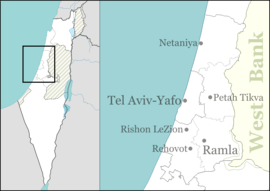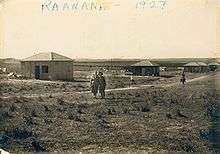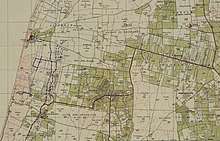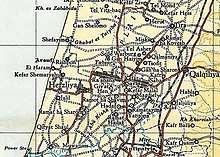Ra'anana
Ra'anana (Hebrew: רַעֲנָנָּה, lit. "Fresh") is a city in the heart of the southern Sharon Plain of the Central District of Israel. It was founded in 1922 as an American-Jewish settlement,[2] and subsequently expanded over the ruins of the depopulated Palestinian village of Tabsur.[3]
Ra'anana
| |
|---|---|
| Hebrew transcription(s) | |
| • ISO 259 | Raʿanana |
 Coat of arms of Raanana | |
 Ra'anana  Ra'anana | |
| Coordinates: 32°11′N 34°52′E | |
| Country | |
| District | Central |
| Founded | 2 April 1922 |
| Government | |
| • Type | City |
| • Mayor | Chaim Broide |
| Population (2019)[1] | |
| • Total | 75,421 |
Bordered by Kfar Saba on the east and Herzliya on the southwest, it had a population of 75,421 in 2019.[1] While the majority of its residents are native-born Israelis, a large part of the population are immigrants from the Americas and Europe.
Ra'anana's high tech industrial park is home to many leading global companies and local start up companies. It was designated a "Green City" award by the World Health Organization in 2005.[4]
History

In 1912, the Company for Jewish Settlement in Israel formed the "Ahuza A – New York" group to purchase land in Palestine for agricultural settlement. World War I delayed their plans, but in 1921, it was decided to establish a settlement. On 2 April 1922, two wagons left the corner of Lilienblum and Herzl Streets in Tel Aviv carrying four "Ahuza" members, three laborers and two armed watchmen. After a five-hour journey, they unloaded their baggage at the place destined to become Ra'anana.
In its early days, the settlement was called "Ahuza A – New York." The Arabs of the region called it "Little America" as most of its residents were English speakers and came from New York. Later it was renamed "Ra'anania" and finally the founding settlers chose "Ra'anana" as its official name.
The settlement was built along a main street, Ahuza Street, and six other streets, three to the north of Ahuza Street and three to the south. Between 1925 and 1927, the Community House, which would house a variety of public institutions, including the secretariat, clinic, synagogue, meeting place for local committee meetings, assembly hall, culture room, school, kindergarten, clinic, and post office, was built.[5] According to a census conducted in 1931 by the British Mandate authorities, Ra'anana had a population of 615 inhabitants in 182 houses.[6]
In 1936, it was given local council status. By 1948, the year of Israel's formation, Ra'anana was a town of 3,000 residents. This had grown to 5,900 in 1949. By the late 1960s, Raanana had a population of 8,500 spanning an area of 15 square kilometres (6 sq mi).[7] In the 1980s Ra'anana was declared a city.
 Raanana in 1935
Raanana in 1935 Ra'anana 1942 1:20,000
Ra'anana 1942 1:20,000 Ra'anana 1945 1:250,000
Ra'anana 1945 1:250,000 Raanana in 1964
Raanana in 1964
Local government
Mayors

- Baruch Ostrovsky (1931–1955, 1957–1959)
- Michael Pasweig (1955–1957, 1959–1960)
- Yitzhak Skolnik (1960–1969)
- Benyamin Wolfovich (1969–1989)
- Ze'ev Bielski (1989–2005, 2013–2018)
- Nahum Hofree (2005–2013)
- Eitan Ginzburg (2018)[8]
- Chaim Broyde (2018–Present)
Demographics
Ra'anana's population consists mainly of native-born Israelis, but about 22% of the city's residents are immigrants to Israel. It is home to a large number of immigrants from English-speaking countries, a significant number of immigrants from Latin America, mainly Argentina, and also absorbed large numbers of immigrants from the former Soviet Union. The number of French immigrants is also on the rise.[9][10]
Though the majority of Ra'anana residents are secular, there is a sizeable religious community, mainly consisting of Modern Orthodox Jews, many of whom are immigrants from the US, UK, South Africa and France. The religious community generally lives on the north side and the secular community on the southern sides. There are nearly 100 synagogues in Ra'anana, ranging from small minyanim to large edifices, and including a wide range of traditions, including Progressive (Reform), Sefaradi, Ashkenazi, Yemenite, Afghani and Libyan synagogues. Many of these synagogues cater to specific immigrant groups. There is also a small Hasidic community of Clevelander Hasidim, led by the Clevelander Rebbe of Ra'anana, Rabbi Yitzchok Rosenbaum. The orthodox chief rabbi of the city is Rabbi Yitzhak Peretz.[11]
Industry and commerce
Ra'anana has an industrial zone in the north of the city, which is home to Renanim shopping mall and many high-tech companies, including Emblaze, Hewlett-Packard, NICE Systems, SAP, NCR Corporation (formerly Retalix), Comverse, Red Hat, Waze (prior to Google acquisition), Texas Instruments and Arm Holdings. In addition, Microsoft's head office in Israel and Amdocs are located in an office complex at the eastern edge of the city, close to Ra'anana Junction, where Highway 4 meets Ahuza Street, Ra'anana's main boulevard. Ahuza Street runs through the city from east to west and is lined with shops, restaurants and a cultural center.
Education
Ra'anana has 12 elementary schools, 10 middle schools and 8 high-schools.
Educational programs for gifted students start in the third grade. A program for the encouragement of girls to study technological subjects has been developed as well as a technology-focused leadership development and information management program, the first of its kind in Israel. The program, created in conjunction with "Ness Technologies", uses advanced technology as a catalyst for developing skills.
Ra'anana has developed supplementary education programs for the afternoon and evening hours, which meet the needs of thousands of children, aged 5–18. These programs foster creativity, promote social involvement and cultivate leadership skills. The supplementary education projects include over 20 "Batei Talmid" citywide extracurricular programs, an afternoon daycare program, and music, dance, art and science centers. Other programs include summer camps and summer activities, university for youth, dance troupes, the Children's Parliament, an acting school, a school for the performing arts, and gifted children programs, that serve as a model for many other cities.
Ra'anana is home to the Open University of Israel and Ra'anana College.
Parks and museums
The park of Ra'anana is the largest urban park in the Sharon region. It offers walking and bike paths, sports fields, a zoo and children's petting corner and a lake in a clover shape reminiscent of Ra'anana's coat of arms. There are two fountains in the lake and pedestrians can cross over it on the bridge. The lake is surrounded by special gardens, including the Seven Species garden, and shaded walking paths. There is also a restaurant and small art gallery. The Founders Museum presents the story of Ra'anana's original settlers, from the arrival of the Ahuza Alef-New York Association until Ra'anana achieved local council status in 1936.[12]
Ra'anana Park Amphitheatre has been the venue for musical acts such as Backstreet Boys, Evanescence, Alice Cooper, Lauryn Hill, Tori Amos, Chick Corea, Ian Anderson, Ziggy Marley, The Cranberries, The Stranglers, Seal, Brian Wilson, Regina Spektor, Blondie and Pet Shop Boys.
Hospitals and medical facilities
Ra'anana is home to the Loewenstein Hospital Rehabilitation Center. Loewenstein was established in 1958 and is the only rehabilitation hospital operated by Clalit Health Services, Israel's largest health care provider. Its current multi-floor building is situated in a large gardened area and accommodates 240 rehabilitative beds for short and long term hospital care.
As a national rehabilitative center, patients are admitted from all parts of the country, all health funds, from the Ministry of Defense, the Ministry of Health, and from general hospitals and clinics, both from Israel and overseas.[13]
The Loewenstein campus also hosts other Clalit services such as a child development center and a clinic for alternative holistic treatments partially subsidized by Clalit's insurance plan.
Sports
The main soccer club of the city is Hapoel Ra'anana. In basketball, the city is represented by Maccabi Ra'anana who play in the National League.[14]
The Ra'anana Roosters are the local rugby team, and the area is a center of rugby union in Israel, with Rugby Israel being based there. With a large population of American expatriates, the Ra'anana Express are an inaugural team in the Israel Baseball League.
Notable residents
- Tamar Ariav (born 1949), professor of education and President of Beit Berl College
- Naftali Bennett, politician, leader of The Jewish Home party, Minister of Education
- Peter Deutsch, former US congressman
- Raanan Gissin, political scientist
- Israel Gohberg, Israeli mathematician
- Yael Grobglas, Israeli actress
- Yihye Haybi, photographer
- Haim Hefer, Israeli songwriter, poet, and writer
- Noa Kirel, Israeli singer, actress, and television host
- Uzi Landau, former politician, former minister
- Keren Leibovitch, champion Paralympic swimmer
- Paul L. Smith, American-born actor
- Rami Bar-Niv, Concert pianist, composer and author
- Yehuda Levi, Israeli Actor, Male Model
- Mili Avital, Israeli actress
- Yotam Halperin, Israeli basketball player
- Yoni Wolf, Male Model
- Shuli Natan, Israeli singer
- Ruhama Raz, Israeli singer
- Dani Litani, Israeli musician
Twin towns
Ra'anana has twin cities agreements with:[15]
|
References
- "Population in the Localities 2019" (XLS). Israel Central Bureau of Statistics. Retrieved 16 August 2020.
- Joseph B. Glass (5 February 2018). From New Zion to Old Zion: American Jewish Immigration and Settlement in Palestine, 1917-1939. Wayne State University Press. pp. 198–. ISBN 978-0-8143-4422-4.
- Noga Kadman (7 September 2015). Erased from Space and Consciousness: Israel and the Depopulated Palestinian Villages of 1948. Indiana University Press. pp. 203–. ISBN 978-0-253-01682-9.
- Sinai, Ruth (2005-09-29). "Ra'anana receives WHO safety award". Haaretz. Retrieved 2013-03-12.
- http://eng.shimur.org/Rishonim-raanana/
- Mills, 1932, p. 15
- Patai, Raphael, ed. (1971). "Ahuza". Encyclopedia of Zionism and Israel. Vol. 1. New York: Herzl Press/McGraw-Hill. p. 17.
- "Ra’anana gets Israel's first openly gay mayor", Times of Israel, March 16, 2018. https://www.timesofisrael.com/raanana-gets-israels-first-openly-gay-mayor/
- Hoffman, Carl (2006-09-07). "Ra'anana's French revolution". The Jerusalem Post. Retrieved 2009-05-06.
- http://www.raanana.muni.il/English/Residents/Services/Pages/default.aspx
- Ra'anana Religious Council
- Yad Labanim
- "Loewenstein Hospital Rehabilitation Center". Clalit Health Services. Retrieved 23 May 2011.
- Maccabi Raanana basketball team – Eurobasket.com
- "Ra'anana Twin towns & Sister cities - Friends around the World". raanana.muni.il. Archived from the original on 30 April 2010. Retrieved 24 March 2010.
- "Stedenband Opsterland-Ra'anana" [City Connection Opsterland-Ra'anana]. Stedenbanden.nl. Archived from the original on 2011-07-24.
Vanaf 1960 onderhoudt de gemeente Opsterland contacten met de gemeente Ra'anana. Deze contacten zijn in 1963 officieel vastgelegd in een 'vriendschapsverdrag'. In maart 2000 is een delegatie naar Ra'anana gereisd om te praten over een meer themagerichte invulling van het verdrag.
- Being the first to twin, a central street in the Ra'anana is named "Opsterland"
- "Comune di Verona - Grandi Eventi - Gemellaggi e Patti d'Amicizia" (in Italian). City of Verona. Retrieved 2019-11-11.
"Verona twinning" (in Hebrew). City of Ra'anana. Retrieved 2019-11-11. - "Poznań - Miasta partnerskie". 1998–2013 Urząd Miasta Poznania (in Polish). City of Poznań. Archived from the original on 2013-09-23. Retrieved 2013-12-11.